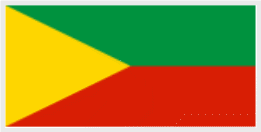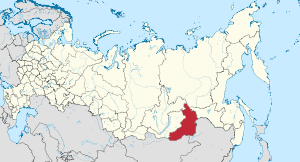ЗАБАЙКАЛЬЕ. Пояснительная записка Учебное пособие составлено в качестве приложения к умк по английскому языку в виде регионального социокультурного компонента и предназначено
 Скачать 498.12 Kb. Скачать 498.12 Kb.
|
|
Министерство образования, науки и молодежной политики Забайкальского края Государственное профессиональное образовательное учреждение Приаргунский государственный колледж Regional Socio-Cultural Component of Education  Priargunsk 2019 Пояснительная записка Учебное пособие составлено в качестве приложения к УМК по английскому языку в виде регионального социокультурного компонента и предназначено для учащихся и студентов среднего профессионального образования для работы на уроках и во внеурочной деятельности. В брошюре представлены аспекты жизни нашего региона: история, географическое положение, население, растительный и животный мир, знаменитые люди Забайкалья и т.д. Материал пособия позволит расширить рамки учебных занятий по английскому языку. Предлагаемые упражнения к учебным текстам, а также задания для самостоятельной работы будут иметь познавательный характер и, безусловно, будут интересны учащимся и студентам. Contents General information Administrative divisions of Zabaikalsky Krai Zabaikalsky Krai history Geographical location, climate Borders Population Nature Chita-the capital of Zabaikalie Gallery of Famous Chita citizens Zabaikalsky Krai Red Book References Ι. General information Zabaikalsky Krai Flag   Coat of arms Anthem: None Zabaikalsky Krai at the map of Russian Federation 
«In Zabaikalie I found all I wanted: the Caucasus, Zvenigorod district and the Don. In the afternoon you rode in the Caucasus, at night you were in the Don steppe, and in the morning I found myself in Poltava province». Anton Pavlovich Chekhov Zabaykalsky Krai is a federal subject of Russia that was created on March 1, 2008 as a result of a merger of Chita Oblast and Agin-Buryat Autonomous Okrug, after a referendum held on the issue on March 11, 2007. The administrative center of the krai is located in the city of Chita. Population: 1,106,611 KonstantinIlkovsky, the Governor of Zabaikalsky Krai was elected Governor of Zabaykalsky Krai on September,2013. He assumed the post on September 18, 2013. Currently Zabaikalsky Krai is divided into 31 districts, 10 towns and 45 villages. ΙΙ. Administrative divisions of Zabaykalsky Krai
Agin-BuryatOkrug Districts: Aginsky (Агинский) Urban-type settlements under the district's jurisdiction: Aginskoye (Агинское) (administrativecenter) Novoorlovsk (Новоорловск) Orlovsky (Орловский) Duldurginsky (Дульдургинский) Mogoytuysky (Могойтуйский) Urban-type settlements under the district's jurisdiction: Mogoytuy (Могойтуй) Urban-type settlements under the federal government management: Gorny (Горный) Cities and towns under the krai's jurisdiction: Chita (Чита) (administrativecenter) administrativedistricts: Chernovsky (Черновский) Ingodinsky (Ингодинский) Tsentralny (Центральный) Zheleznodorozhny (Железнодорожный) Districts: Akshinsky (Акшинский) Alexandrovo-Zavodsky (Александрово-Заводский) Baleysky (Балейский) Towns under the district's jurisdiction: Baley (Балей) Borzinsky (Борзинский) Towns under the district's jurisdiction: Borzya (Борзя) Urban-type settlements under the district's jurisdiction: SherlovayaGora (Шерловая Гора) Chernyshevsky (Чернышевский) Urban-type settlements under the district's jurisdiction: Aksyonovo-Zilovskoye (Аксёново-Зиловское) Bukachacha (Букачача) Chernyshevsk (Чернышевск) Zhireken (Жирекен) Chitinsky (Читинский) Urban-type settlements under the district's jurisdiction: Atamanovka (Атамановка) Novokruchininsky (Новокручининский) Yablonovo (Яблоново) Gazimuro-Zavodsky (Газимуро-Заводский) Kalarsky (Каларский) Urban-type settlements under the district's jurisdiction: NovayaChara (Новая Чара) Kalgansky (Калганский) Karymsky (Карымский) Urban-type settlements under the district's jurisdiction: Darasun (Дарасун) Karymskoye (Карымское) KurortDarasun resort settlement (КурортДарасун) Khiloksky (Хилокский) Towns under the district's jurisdiction: Khilok (Хилок) Urban-type settlements under the district's jurisdiction: Mogzon (Могзон) Krasnochikoysky (Красночикойский) Krasnokamensky (Краснокаменский) Towns under the district's jurisdiction: Krasnokamensk (Краснокаменск) Kyrinsky (Кыринский) Mogochinsky (Могочинский) Towns under the district's jurisdiction: Mogocha (Могоча) Urban-type settlements under the district's jurisdiction: Amazar (Амазар) Davenda (Давенда) Itaka (Итака) Klyuchevsky (Ключевский) Ksenyevka (Ксеньевка) Nerchinsko-Zavodsky (Нерчинско-Заводский) Nerchinsky (Нерчинский) Towns under the district's jurisdiction: Nerchinsk (Нерчинск) Urban-type settlements under the district's jurisdiction: Priiskovy (Приисковый) Olovyanninsky (Оловяннинский) Urban-type settlements under the district's jurisdiction: Kalanguy (Калангуй) Olovyannaya (Оловянная) Yasnogorsk (Ясногорск) Zolotorechensk (Золотореченск) Ononsky (Ононский) Petrovsk-Zabaykalsky (Петровск-Забайкальский) Towns under the district's jurisdiction: Petrovsk-Zabaykalsky (Петровск-Забайкальский) Urban-type settlements under the district's jurisdiction: Balyaga (Баляга) Novopavlovka (Новопавловка) Tarbagatay (Тарбагатай) Priargunsky (Приаргунский) Urban-type settlements under the district's jurisdiction: Klichka (Кличка) Priargunsk (Приаргунск) Shelopuginsky (Шелопугинский) Shilkinsky (Шилкинский) Towns under the district's jurisdiction: Shilka (Шилка) Urban-type settlements under the district's jurisdiction: Arbagar (Арбагар) Kholbon (Холбон) Pervomaysky (Первомайский) Sretensky (Сретенский) Towns under the district's jurisdiction: Sretensk (Сретенск) Urban-type settlements under the district's jurisdiction: Kokuy (Кокуй) Ust-Karsk (Усть-Карск) Tungiro-Olyokminsky (Тунгиро-Олёкминский) Tungokochensky (Тунгокоченский) Urban-type settlements under the district's jurisdiction: Vershino-Darasunsky (Вершино-Дарасунский) Ulyotovsky (Улётовский) Urban-type settlements under the district's jurisdiction: Drovyanaya (Дровяная) Zabaykalsky (Забайкальский) Urban-type settlements under the district's jurisdiction: Zabaykalsk (Забайкальск) ΙΙI. Zabaikalsky Krai history The history of mankind in Zabaikalie dates back to the Stone Age. About 200-300 thousands years ago people first came to settle down along the river banks. Excavations uncovered during the archaeological investigations of the Zabaikalsky Krai, indicate that the first people probably appeared in these places around 100-400 thousand years ago. In the valleys of the rivers Onon and Ilya, and near Lake Balzino, more than 25 traces of Stone Age inhabitants have been discovered. From around 1100-300 BC until the first century of the current era, a culture based around stone burial sites was formed and lasted about 800 years old in the steppes of the Zabaikalsky Krai and Mongolia. In 1,000 A.C. the territory of present Zabaikalsky krai was inhabited by the tribes of Evenks and later - Buryats. From the 18th century the territory behind Baikal was assimilated by Russian colonists. Among the first colonists there were a lot of exiled old believers. From 1782-1783 the krai was a part of Nerchinskaya (Zabaikalskaya) oblast of Irkutsk territory ruled by governor-general, from 1851 Zabaikalskaya oblast was a part of Irkytskaya gubernia with the capital in Chita. Since 19th century mining has been the main industry of the region. A lot of exiled people worked at mines and plants of the oblast. After rebellion of December 14th, 1825, dozens of Decembrists were exiled there (brothers Bestuzhev, M.S.Lunin, N.M.Muravyov, C.G.Volkonsky, A.I.Yakubovich and others), later wives of some of them came to live there. The Decembrists influenced the development of the culture in the krai. In 1851 Zabaikalskaya Cossack army with the center in Chita was formed. At the end of 19th century the construction of Trans-Siberian railway forced the economic development of Zabaikalsky krai. During Civil war there were heavy fights of the Red Army with Kolchak and G.M.Semyonov armies on the territory of the krai. On April 6, 1920, Dalnevostochnaya republic was formed. In 1922 it became the part of the RSFSR. In April 1926 Zabaikalskaya gubernia was divided into Chitinsky and Sretensky districts which were the parts of Dalnevostochny krai. At the end of 1920 - early 1930s during collectivization Cossack settlements were destroyed; Buryat - cattle-breeders - were forced to have a settled way of life. In March 1934 Chitinskaya oblast was formed, it became a part of Vostochno-Sibirsky krai. On September 26, 1937, Vostochno-Sibirsky krai was divided into Irkutskaya and Chitinskaya oblasts. Within Chitinskaya oblast there was AginskyBuryat-Mongol national district formed. On March 2nd, 1969, there was an armed conflict on the Soviet-China border close to frontier point Nizhne-Mikhailovka on the island Damansky. The present day Zabaikalsky krai was formed on March 1, 2008 by uniting Chitinskaya oblast and AginskyBuryatsky autonomous okrug. Put the words in the following sentences in order, the first word in each sentence is in italics. Translate them into Russian. Back/ of /The history /Zabaikalie/ Stone /mankind /in/dates /to /the /Age. ago /people/ probably /places/ 100-400 thousand/ appeared/The first/ in/ these/ around/ years. the 18th/ the/From/behind/ territory/ century/ Baikal /assimilated/ was /by Russian/ colonists. 19th/ century/ the /main/ mining/ been/ the/ industry/ Since/ has/ of/ region. Dalnevostochnaya/ was/On April 6, 1920,/republic /formed. In/was/ 1934/ Chitinskaya/ March /oblast/ formed. Zabaikalsky/ The present day/ formed/ March 1, 2008/ krai /was/ on. Agree or disagree with the following statements. Add some more information. The history of mankind inZabaikalie dates back to the Middle Ages. About 200-300 thousands years ago people first came to settle down along the river banks. In 1,000 A.C. the territory of present Zabaikalsky krai was inhabited by the tribes of Mongols and later - Evenks. From the 20th century the territory behind Baikal was assimilated by Russian colonists. Since 19th century machine building has been the main industry of the region. The present day Zabaikalsky krai was formed on March 1, 2008. Translate the following sentences from Russian into English. You will have a story about the history of Zabaikalie. История возникновения человечества в Забайкалье восходит к каменному веку. Около 200-300 тысяч лет назад люди впервые пришли, чтобы расселиться по берегам рек. В 1000 году н.э. территория нынешнего Забайкальского края была заселена племенами эвенков, а позже - бурят. С 1782 по 1783 годы край под управлением генерал-губернатора был частью Нерчинской (Забайкальской) области Иркутской территории. С 1851 Забайкальская область была частью Иркутской губернии со столицей в Чите. После восстания декабристов 14 декабря 1825, десятки декабристов были сосланы туда (братья Бестужевы, Лунин, Муравьев, Волконский и др.), позже жены некоторых из них приехали туда. В 1851 году было образовано Забайкальское казачье войско с центром в Чите. 6 апреля 1920 г. была образована Дальневосточная республика. В апреле 1926 года Забайкальская губерния была разделена на Читинский и Сретенский районы, которые были частями Дальневосточного края. В марте 1934 года была сформирована Читинская область, она стала частью Восточно-Сибирского края. 26 сентября 1937 года Восточно-Сибирский край был разделен на Иркутскую и Читинскую области. Забайкальский край был образован 1 марта 2008 года путем объединения Читинской области и Агинского Бурятского автономного округа. | ||||||||||||||||||||||||||||||||||||||||

